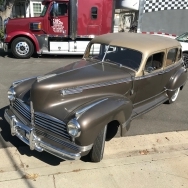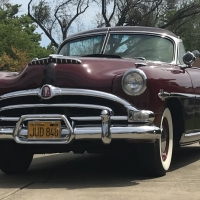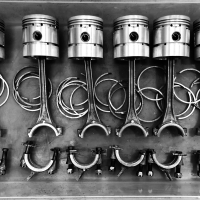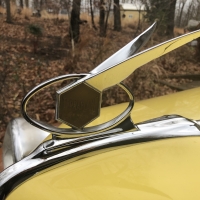Hudson eight - where might it "crack"?
The car: 1942 Commodore 8.
I got it and have been sorting it. It always ran "hot" 3/4+ on gauge(?) Doesn't take much to shoot up to 7/8 on gauge.
New radiator, tune up (timing set correctly) water pump (leaking), water jacket (excellent condition) but it STILL ran hotter than I want it to.
No thermostat, it very quickly goes to 1/2 then holds at 3/4. It is 180 degrees idling in driveway.
No water in the oil.
Maybe it's rust? Add Evaporust. Run it for several months many heat cycles. Finally I figure it's ready to drain, flush and refill. The Evaporust worked great, the passages are all open and clean.
HOWEVER it is leaking coolant from the left rear of the head gasket. No problem, pull the head and change the gasket
No, its stuck! Arrrrggggg!!!!
Chisels and screwdrivers and I get the head off. (corroded around the studs) Motor looks clean inside. Valves not burnt. Had good compression previously. Scrape the carbon, clean everything up. Resurface the head, reassemble.
Now it is acting the same way. getting hot, but not boiling over. No thermostat, it very quickly goes to 1/2 then holds at 3/4. It is 180 degrees idling in driveway. No water in the oil.
What's left to check? I get out the block check fluid and sure enough it turns yellow :'( But it doesnt change quickly, maybe it's just a small combustion leak?
When the head was off, I didnt see any cracks . . . . . It runs too good to tear it down for a full rebuild.
Perhaps I can pull the head again and do some magnaflux or other crack detection?
If I do that, where do Hudson eights typically crack?
Or if combustion is getting in the radiator where else might it be coming from?
I got it and have been sorting it. It always ran "hot" 3/4+ on gauge(?) Doesn't take much to shoot up to 7/8 on gauge.
New radiator, tune up (timing set correctly) water pump (leaking), water jacket (excellent condition) but it STILL ran hotter than I want it to.
No thermostat, it very quickly goes to 1/2 then holds at 3/4. It is 180 degrees idling in driveway.
No water in the oil.
Maybe it's rust? Add Evaporust. Run it for several months many heat cycles. Finally I figure it's ready to drain, flush and refill. The Evaporust worked great, the passages are all open and clean.
HOWEVER it is leaking coolant from the left rear of the head gasket. No problem, pull the head and change the gasket
No, its stuck! Arrrrggggg!!!!
Chisels and screwdrivers and I get the head off. (corroded around the studs) Motor looks clean inside. Valves not burnt. Had good compression previously. Scrape the carbon, clean everything up. Resurface the head, reassemble.
Now it is acting the same way. getting hot, but not boiling over. No thermostat, it very quickly goes to 1/2 then holds at 3/4. It is 180 degrees idling in driveway. No water in the oil.
What's left to check? I get out the block check fluid and sure enough it turns yellow :'( But it doesnt change quickly, maybe it's just a small combustion leak?
When the head was off, I didnt see any cracks . . . . . It runs too good to tear it down for a full rebuild.
Perhaps I can pull the head again and do some magnaflux or other crack detection?
If I do that, where do Hudson eights typically crack?
Or if combustion is getting in the radiator where else might it be coming from?
0
Comments
-
The new radiator is it the same number of tubes, and thickness as the factory one? I went thru all this to find that someone put a replacement radiator that was not up to spec,0
-
Have you used a laser heat gun to check the actual temperature? You may have a bad gauge and sender. If it is not boiling or blowing water out you may be worrying about nothing.0
-
New rad ??? Is a Hudson 8 rad ? Is it aftermarket? Are you running a 7 lb cap or less? ?0
-
The radiator was recorded using the original. He was an old experienced radiator guy who has now died.I guess the factory cap was a zero pressure “cap”. I now have a NOS 4 pound cap that I commonly leave “lose”. It was splashing out water before.I would like to add an aftermarket mechanical gauge but there are few if any unused holes in the firewall and I don’t want to punch any new holes.0
-
I have seen the exact same symptoms/problems on my father’s 39 8 cylinder. Turns out that the recored radiator was 1/3 full of all of the nasty scaly rust that had freed itself once a few miles and heat cycles had been put on the engine. This was a car that had been sitting dead for +20 years and had received water pump, recored radiator, water jacket removed and cleaned, etc. We flushed the engine block prior to all of that but nothing could free up all the build up like driving it. Went to take the radiator out and was surprised at how much the “drained” radiator weighed.0
-
A good friend is having the same problem with his 38 Hudson 8 cylinder engine, so let us know what you end up finding as it sounds the same as all he’s doing as well.Thermostat: an old SAE mechanic schooled me on the need to use a thermostat. He said going without a thermostat will raise coolant temperatures because the coolant doesn’t have enough time in the radiator to get the temp down.Radiator: another friend had his 37’s 8 cyl engine radiator remade & they didn’t build it correctly.Thermocure is great stuff & I used it on both my Hudson’s & man does that water turn black from converting rust!
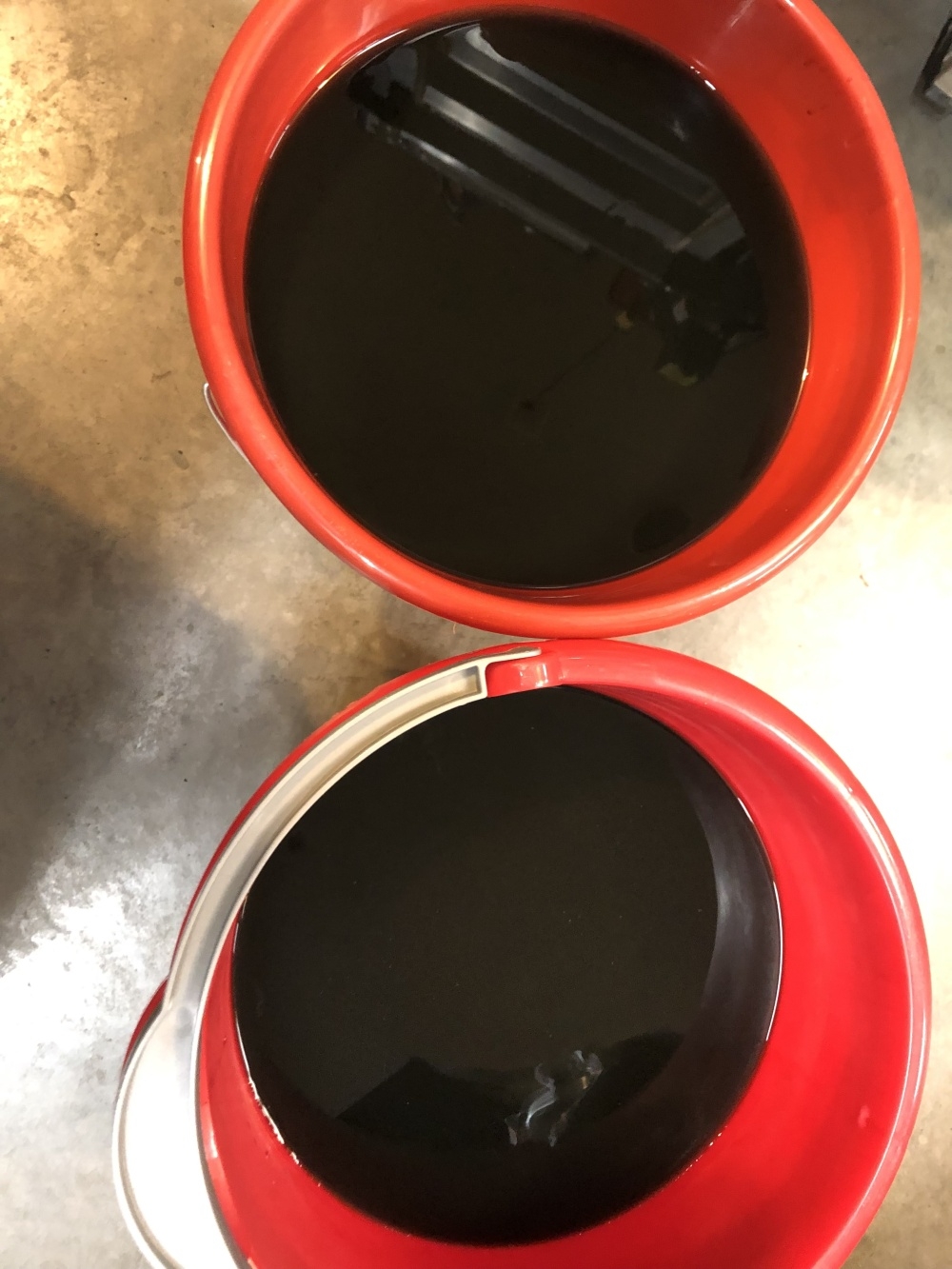 0
0 -
"Thermostat: an old SAE mechanic schooled me on the need to use a thermostat. He said going without a thermostat will raise coolant temperatures because the coolant doesn’t have enough time in the radiator to get the temp down."
Yeah, I have heard that for years also. . . . . BUT I have also had many cars over the years (that were all in good shape) and without a thermostat they all ran cold. By the above logic, you should be able to remove the thermostat from a car with a top condition cooling system and it should immediately run hot.
In my mind it doesn't make sense. IF a car needs a thermostat to "run cooler" (by slowing the flow through the radiator) then why would it also need a thermostat to slow the water flow to cause it to heat up? You cant have it both ways.
Since my car DOES show combustion products in the cooling system (block check fluid) I KNOW that somehow and somewhere combustion gasses are getting into the cooling system. (and warming it up). It is not much and the gasses are flowing just one way (because there is no water in the oil)
The Symptoms that I am seeing are having the gauge go higher when the engine is under power (going uphill or accelerating) and cooling down when coasting or low power cruising. Clearly a mark of having combustion gasses forced into the coolant.
It is otherwise a good solid engine and I certainly DONT want to pull it for a full rebuild. My next thought is to work on acquiring a magnaflux magnet and maybe the spray, then pulling the head (again) and go on a crack hunting expedition.
I used Evaporust and YES(!) it worked very well and turned very black.0 -
“By the above logic, you should be able to remove the thermostat from a car with a top condition cooling system and it should immediately run hot.” One can’t assume that is the case. I would imagine there is a range where it may run just fine without a thermostat but if there are issues in a system, which most old cars tend to develop over time, then it very well may need the thermostat to allow it to function properly.Bottom line, if you don’t like my suggestion you’re more than welcome to keep looking. I was just offering some advice from someone that has forgotten more than most will ever know about auto mechanics. Best of luck0
-
The thermostat is basically a plug that opens when it gets hot. An internal combustion engine runs best when it is warmed up, and without a thermostat it will take longer to warm up, hence inefficient. And in freezing conditions it will also run too cold. Without a thermostat your heater will take longer to work. if the radiator is doing it's job, then the thermostat will allow enough water to circulate and keep the temperature constant. It is an essential piece of equipment. My two bits worth.0
-
Did you remove the water jacket cover to inspect for rust out?0
-
Yes water jacket was clear and without rust.0
-
Are you certain your water pump impeller is moving the water?0
-
Yes. I got a NOS water pump with the car and installed it when the old one began leaking.
0
Categories
- 36.9K All Categories
- 113 Hudson 1916 - 1929
- 20 Upcoming Events
- 92 Essex Super 6
- 28.6K HUDSON
- 574 "How To" - Skills, mechanical and other wise
- 995 Street Rods
- 151 American Motors
- 178 The Flathead Forum
- 49 Manuals, etc,.
- 78 Hudson 8
- 44 FORUM - Instructions and Tips on using the forum
- 2.8K CLASSIFIEDS
- 608 Vehicles
- 2.2K Parts & Pieces
- 77 Literature & Memorabilia
- Hudson 1916 - 1929 Yahoo Groups Archived Photos
